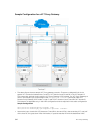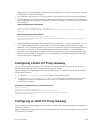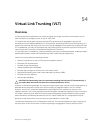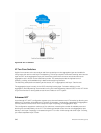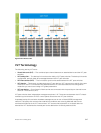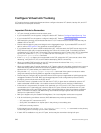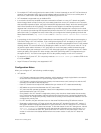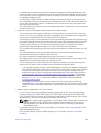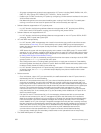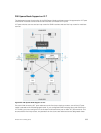
– The chassis members in a VLT domain support connection to orphan hosts and switches that are
not connected to both switches in the VLT core.
• VLT interconnect (VLTi)
– The VLT interconnect must consist of either 10G or 40G ports. A maximum of eight 10G or four
40G ports is supported. A combination of 10G and 40G ports is not supported.
– A VLT interconnect over 1G ports is not supported.
– The port channel must be in Default mode (not Switchport mode) to have VLTi recognize it.
– The system automatically includes the required VLANs in VLTi. You do not need to manually select
VLANs.
– VLT peer switches operate as separate chassis with independent control and data planes for
devices attached to non-VLT ports.
– Port-channel link aggregation (LAG) across the ports in the VLT interconnect is required; individual
ports are not supported. Dell Networking strongly recommends configuring a static LAG for VLTi.
– The VLT interconnect synchronizes L2 and L3 control-plane information across the two chassis.
– The VLT interconnect is used for data traffic only when there is a link failure that requires using
VLTi in order for data packets to reach their final destination.
– Unknown, multicast, and broadcast traffic can be flooded across the VLT interconnect.
– MAC addresses for VLANs configured across VLT peer chassis are synchronized over the VLT
interconnect on an egress port such as a VLT LAG. MAC addresses are the same on both VLT peer
nodes.
– ARP entries configured across the VLTi are the same on both VLT peer nodes.
– If you shut down the port channel used in the VLT interconnect on a peer switch in a VLT domain
in which you did not configure a backup link, the switch’s role displays in the show vlt brief
command output as Primary instead of Standalone.
– When you change the default VLAN ID on a VLT peer switch, the VLT interconnect may flap.
– In a VLT domain, the following software features are supported on VLTi: link layer discovery
protocol (LLDP), flow control, port monitoring, jumbo frames, and data center bridging (DCB).
– When you enable the VLTi link, the link between the VLT peer switches is established if the
following configured information is true on both peer switches:
* the VLT system MAC address matches.
* the VLT unit-id is not identical.
NOTE: If you configure the VLT system MAC address or VLT unit-id on only one of the VLT
peer switches, the link between the VLT peer switches is not established. Each VLT peer
switch must be correctly configured to establish the link between the peers.
– If the link between the VLT peer switches is established, changing the VLT system MAC address or
the VLT unit-id causes the link between the VLT peer switches to become disabled. However,
removing the VLT system MAC address or the VLT unit-id may disable the VLT ports if you happen
to configure the unit ID or system MAC address on only one VLT peer at any time.
– If the link between VLT peer switches is established, any change to the VLT system MAC address or
unit-id fails if the changes made create a mismatch by causing the VLT unit-ID to be the same on
both peers and/or the VLT system MAC address does not match on both peers.
– If you replace a VLT peer node, preconfigure the switch with the VLT system MAC address, unit-id,
and other VLT parameters before connecting it to the existing VLT peer switch using the VLTi
connection.
– If the size of the MTU for VLTi members is less than 1496 bytes, MAC addresses may not be
synced. Dell Networking recommends retaining the default MTU allocation (1554 bytes) for VLTi
members.
• VLT backup link
950
Virtual Link Trunking (VLT)



